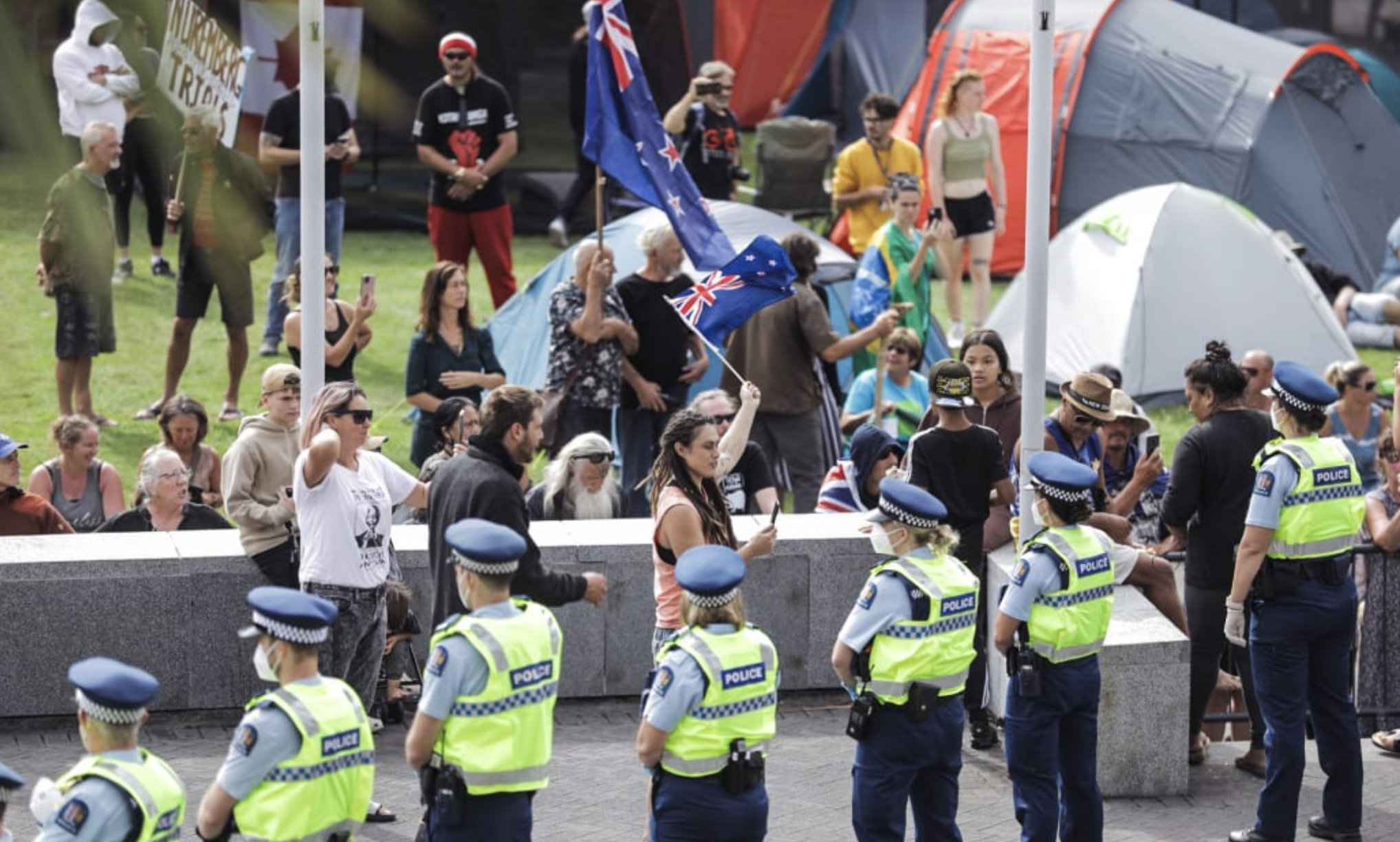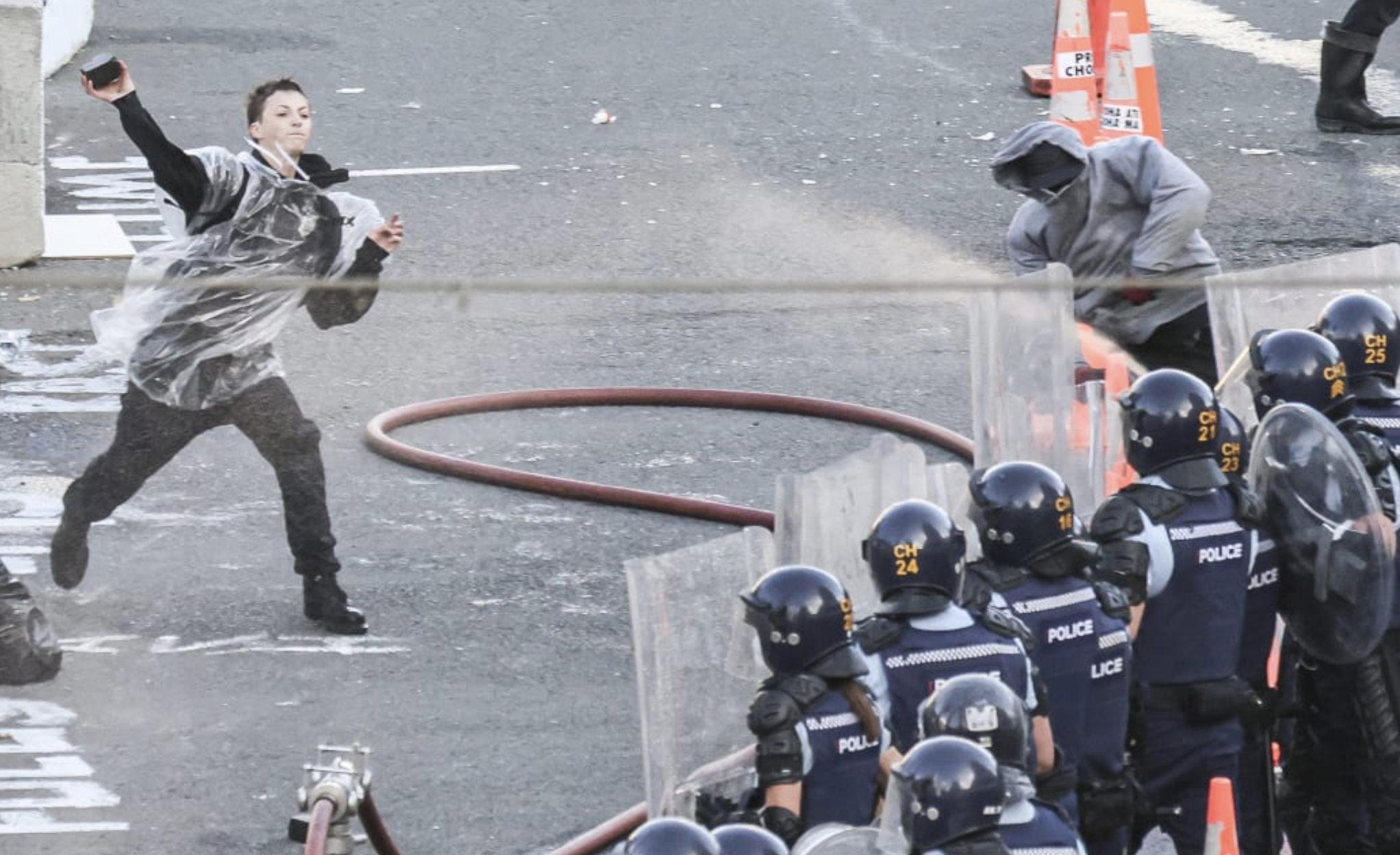The police watchdog has found, despite a number of police failings during the Parliament protest, officers served the public well in the face of at times "extreme provocation".
The Independent Police Conduct Authority (IPCA) this morning released its more than 200-page report into police actions during the three-week long illegal occupation of the Beehive precinct and surrounding areas in February and March last year.
It found almost all officers exercised professionalism and restraint dealing with a "level of public disorder rarely seen in New Zealand".
The occupation culminated in a fiery riot where officers faced "violent behaviour" from some protesters, who pelted them with bricks and other objects.
The IPCA said all police defensive measures that day - including shields, pepper spray and batons - were justified.
But it also found a number of faults by police. It said some officers were not given enough protective gear on that final day, resulting in a number of staff injuries.

Nearly 2000 complaints about officers were made to the IPCA. It is investigating 19 incidents, with provisional findings showing police actions were unjustified on six occasions.
The IPCA also said police broke legal protections for the treatment of some of those arrested during the first attempt to break up the occupation.
Other problems pointed out included deploying trainee and recent graduate officers with little training. It also said issues collecting evidence during the two mass arrests meant many charges had to be dropped.

Police welcome report findings
The report concluded the law for mass public disorder situations like that in February-March 2022 was not fit for purpose in a number of areas.
The IPCA made a number of recommendations, including that police should ask the Government to review legislation.
All in all, IPCA chair Judge Colin Doherty said police did a good job and it was commendable they were able to end the occupation "with as few injuries and as little damage to property as they did".
The report said officers exercised professionalism and restraint dealing with a "level of public disorder rarely seen in New Zealand".
There were some isolated incidents of potentially excessive force by officers, which were being investigated separately.
Police Commissioner Andrew Coster today welcomed the IPCA's findings that police served the public well overall, saying he was immensely proud of the work of staff throughout the protest and on the final day of the occupation.
Officers faced an exceptionally challenging, provocative, and sometimes, very volatile environment, he said.
"This was an unprecedented event and it will be regarded as one of the most significant policing challenges in decades. Despite that, the authority found we did many things right, particularly the overall use of force being appropriate in the circumstances. The report also highlights areas for improvement, including public order policing, planning, command and control, equipment and health and safety."
The report said some officers were not given enough protective gear on the final day, resulting in a number of staff injuries.
"We have completed a significant amount of work already, such as ordering more equipment, providing staff with more training, and beginning a full review of public order policing," Coster said.
"The review into public order policing will investigate issues of training and equipment. More protective equipment has been sourced already to create a centralised store."
He agreed that ideally, more officers would have had been fully equipped with specialist protective equipment, but at the time of the operation it had exhausted all options to do so, including utilising partner agencies.
Coster said extensive effort had gone into staff safety, and was confident that health and safety was at the forefront.
The final report makes a number of recommendations, which would now be incorporated into the work programme under way, he said.

The first attempt to end the occupation
On February 10, a few days after several hundred protesters had set up tents on Parliament's lawn and some surrounding areas grounds, police tried to force them out.
Officers formed a line at 8am and a wall of officers and protesters clashed - 108 people were arrested, but the attempt to end the protest failed.
The report said police made the decision to move in that day independently, and there was no undue political interference.
The watchdog found police were unprepared for the operation - there was poor planning and resourcing, some actions were unlawful, and they should have abandoned the attempt earlier.
Officers had not been told clearly what was intended, and some did not have proper equipment.
Police failed to tell all protesters that they must leave the Parliament grounds in the manner required by the Trespass Act. The report said the trespass laws were ill-equipped to deal with a large-scale event like the protest.
Poor evidence recording meant many charges had to be withdrawn, with the IPCA concluding the majority of charges should not have been laid.
The lack of preparation, and the sheer number of arrests, meant police broke both legal protections - and their own internal rules - for the treatment of those in custody (although the watchdog concludes the use of force was "generally reasonable").
Not enough notice was given to staff tasked with processing those arrested, so there was no time to bring on more staff to help. It meant staff at the custody unit were unable to comply with the legal requirement to advise all detainees of their rights and facilitate access to a lawyer.
The IPCA concluded the operation was hurriedly executed by an under-resourced unit and was always "unlikely to succeed". But "that does not mean it was unjustified".
The report mused there was growing frustration about police inaction towards the occupiers in the initial days. It said this would have only grown if they did not attempt to do something.
It demonstrated to the public that police were confronted with a difficult situation and that easy options to end the occupation were not available, the report said.

The final showdown
The police operation to remove the protesters began early morning on March 2. The IPCA said officers faced "substantial and sustained violence" that day.
"This included throwing a Molotov cocktail, bricks, paving stones, fireworks, poles, bottles, a knife and other projectiles.
"By late in the day the protest had degenerated into a riot. At about 6pm a car was used to attack a police line on Lambton Quay."
"In the face of this extreme provocation, while there were some isolated incidents of potentially excessive reactive force by police, they generally acted professionally and with remarkable restraint."
The IPCA found that all the tactics police used to defend both themselves that day were justified in the circumstances.
"These included skirmish lines, shields, pushing and striking, pepper spray, batons, weapons of opportunity (fire extinguishers, fire hoses and paving bricks), sponge rounds and deflating vehicle tyres.
"Police were also justified in carrying firearms (though none were used on the day)."
The use of Long Range Acoustic Devices to communicate with the crowd, and as a tactic against protesters throwing paving bricks, was also justified.
But it said the police plan that day was "incomplete and inadequate" as it did not properly address how to minimise risks to officers safety or manage protesters property.
Some officers did not get body armour when they should have, and a number of officers were injured because of it.
Eighty-two officers were treated for injuries, and six went to the emergency room with serious injuries.
Inexperienced trainees and new graduates were deployed despite not been properly prepared or equipped. Some got a day, or just an afternoon's training.
Police arrested 95 people that day, and charged a further 54 people after the subsequent investigation.
Despite identifying problems during the 10 February operation, issues with evidence collection again meant some charges had to be withdrawn.
"We have found that the current law governing arrest was not fit for purpose for the mass public disorder situation that confronted police on 2 March," the report concludes.
IPCA complaints - eight upheld so far
The IPCA got nearly 2000 complaints, most from people who were not physically at the protest.
It said the vast majority of issues raised are addressed in their report.
Nineteen complaints required specific investigation and further inquiries, with the outcome to be released separately.
These complaints were about specific incidents where the issues raised were unlikely to be sufficiently addressed during its broader investigation and/or the actions of police staff appeared to be excessive in the circumstances and warranted further examination by the IPCA.
Its preliminary findings are that police actions were unjustified in eight of the 19 complaints investigated.
Concrete bollards, containment the 'right approach'
The IPCA said the police move to contain the protest and buy time to plan for how to end it was the "right approach".
Installing large concrete block bollards stopped new vehicles being able to join the protest, containing the occupation's sprawl and then shrinking it. It contributed to the success of the final operation on 2 March, the report concluded.
It noted an attempt to ask tow truck operators to help remove protesters' vehicles was largely unsuccessful.
The police's legal powers to remove the vehicles blocking roads were limited. They did not have the power to impound vehicles, so could not have prevented owners from immediately rejoining the blockade once they had recovered their vehicle.

Could the police have stopped the the occupation happening at all?
The IPCA found the police intelligence staff provided good information ahead of, and during, the occupation, and passed this onto police decision-makers appropriately.
But it found that despite similar disruptive convoy protests overseas - like in Canada and Australia - police did not sufficiently consider the risk it would happen here.
They placed "undue reliance" on information that the protest would conclude at the end of the day on 8 February, and were unaware of or failed to take into account other contrary information.
The watchdog said police should have had more detailed plans in place ahead of time, and consulted with the Wellington City Council over traffic management well before the convoy arrived.
But the watchdog concluded it was unclear actions such as closing the roads around Parliament would have "changed the path of the protest".
The IPCA concluded that it would have "made no difference to the likely course of events".
"Police did not have the legal authority to end the protest at that stage, and even if they had, lacked the capacity to do so."
Once the protesters had arrived in substantial numbers on 8 February, there was nothing police could realistically do to prevent the occupation, the report said.
Findings and recommendations
The IPCA recommended the police:
• urgently buy more body armour
• come up with detailed criteria for when officers should use protective equipment and carry long batons, protective spray and other tactical options
• work out how to better communicate with disparate groups which do not have unified leadership.
The report concluded the law is not fit for purpose for the mass public disorder situation in a number of areas. These included:
• the law of trespass
• the law governing how arrests may be lawfully effected
• the law governing how property left behind by trespassers should be handled.
The IPCA said police should ask the Government for a multi-agency review of the laws governing a "public order event" such as this.













